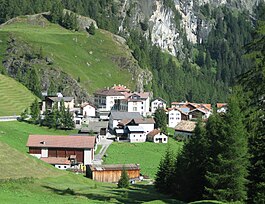Mulegns
Mulegns | |
|---|---|
 | |
| Coordinates: 46°31′N 9°37′E / 46.517°N 9.617°E | |
| Country | Switzerland |
| Canton | Graubünden |
| District | Albula |
| Area | |
• Total | 33.79 km2 (13.05 sq mi) |
| Elevation | 1,481 m (4,859 ft) |
| Population (2006) | |
• Total | 26 |
| • Density | 0.77/km2 (2.0/sq mi) |
| Time zone | UTC+01:00 (Central European Time) |
| • Summer (DST) | UTC+02:00 (Central European Summer Time) |
| Postal code(s) | 7455 |
| SFOS number | 3534 |
| ISO 3166 code | CH-GR |
| Surrounded by | Avers, Bivio, Ferrera, Marmorera, Riom-Parsonz, Savognin, Sur, Tinizong-Rona |
| Website | surses SFSO statistics |
Mulegns is a village and a former municipality in the Sursés in the district of Albula in the canton of Graubünden in Switzerland. On 1 January 2016 the former municipalities of Bivio, Cunter, Marmorera, Mulegns, Riom-Parsonz, Salouf, Savognin, Sur and Tinizong-Rona merged to form the new municipality of Surses.[1]
History
[edit]Around 600-500 BC, a copper mine and smelter were built in the Val Faller (Faller valley) near modern Mulegns. The village was founded by a Walser group during the 15th Century. It was first mentioned in 1521.[2]
Geography
[edit]
Mulegns had an area, as of 2006[update], of 33.8 km2 (13.1 sq mi). Of this area, 30.1% is used for agricultural purposes, while 9.8% is forested. Of the rest of the land, 0.4% is settled (buildings or roads) and the remainder (59.6%) is non-productive (rivers, glaciers or mountains).[3]
The former municipality is located in the Surses sub-district of the Albula district. It is along the road to the Julier Pass (the Julienstrasse) at the entrance to a side valley of the Val Faller. Until 1943 Mulegns was known as Mühlen.[4]
Demographics
[edit]Mulegns had a population (as of 2014) of 25. Over the last 10 years the population has decreased at a rate of -23.5%.[3]
As of 2000[update], the gender distribution of the population was 50.0% male and 50.0% female.[5] The age distribution, as of 2000[update], in Mulegns is; 3 people or 9.1% of the population are between 0 and 9 years old. 1 person or 3.0% is 10 to 14, and 2 people or 6.1% are 15 to 19. Of the adult population, no one is between 20 and 29 years old. 6 people or 18.2% are 30 to 39, 1 person or 3.0% is 40 to 49, and 5 people or 15.2% are 50 to 59. The senior population distribution is 8 people or 24.2% of the population are between 60 and 69 years old, 6 people or 18.2% are 70 to 79, there is 1 person or 3.0% who is 80 to 89.[6]
In the 2007 federal election the most popular party was the CVP which received 63.3% of the vote. The next two most popular parties were the SVP (20%) and the FDP (8.3%).[3]
In Mulegns about 62.5% of the population (between age 25–64) have completed either non-mandatory upper secondary education or additional higher education (either university or a Fachhochschule).[3]
Mulegns has an unemployment rate of 1.56%. As of 2005[update], there were 12 people employed in the primary economic sector and about 5 businesses involved in this sector. people are employed in the secondary sector and there are businesses in this sector. 1 people are employed in the tertiary sector, with 1 businesses in this sector.[3]
The historical population is given in the following table:[2][5]
| year | population |
|---|---|
| 1850 | 120 |
| 1900 | 146 |
| 1950 | 109 |
| 1960 | 57 |
| 1970 | 66 |
| 1980 | 50 |
| 1990 | 37 |
| 2000 | 33 |
Languages
[edit]Most of the population (as of 2000[update]) speaks Rhaeto-Romance (57.6%), with the rest speaking German(42.4%).[3]
| Languages | Census 1980 | Census 1990 | Census 2000 | |||
|---|---|---|---|---|---|---|
| Number | Percent | Number | Percent | Number | Percent | |
| German | 4 | 8.00% | 10 | 27.03% | 14 | 42.42% |
| Romanish | 46 | 92.00% | 27 | 72.97% | 19 | 57.58% |
| Italian | 0 | 0.00% | 0 | 0.00% | 0 | 0.00% |
| Population | 50 | 100% | 37 | 100% | 33 | 100% |
References
[edit]- ^ Amtliches Gemeindeverzeichnis der Schweiz published by the Swiss Federal Statistical Office (in German) accessed 27 April 2016
- ^ a b Mulegns in German, French and Italian in the online Historical Dictionary of Switzerland.
- ^ a b c d e f Swiss Federal Statistical Office accessed 30-Sep-2009
- ^ Amtliches Gemeindeverzeichnis der Schweiz published by the Swiss Federal Statistical Office (in German) accessed 23 September 2009
- ^ a b Graubunden in Numbers Archived 2009-09-24 at the Wayback Machine (in German) accessed 21 September 2009
- ^ Graubunden Population Statistics Archived 2009-08-27 at the Wayback Machine (in German) accessed 21 September 2009
External links
[edit]- Mulegns in German, French and Italian in the online Historical Dictionary of Switzerland.




